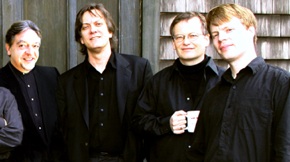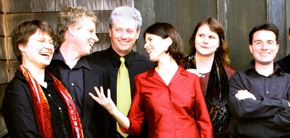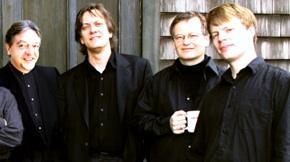There seemed something prescient in one of the 17th-century motets presented by Magnificat on Monday night at Yoshi’s Jazz Club in San Francisco.
“Let there be our pleasure, there our refreshment, there our resting place,” went the text, sweetly sung by sopranos Catherine Webster and Jennifer Ellis Kampani in the original Latin, “where there is a multitude of delight, with such abundance of delicious things.”

Although based on the sort of sacred celebration that was the daily duty of Chiara Margarita Cozzolani, the Milanese nun whose compositions were being showcased by Magnificat, the sentiment fit the modern setting of the performance in a venue where liquid refreshment and a delectable Japanese dinner and appetizer menu were available to the listeners. This was the latest in a series of KDFC In the Clubs, launched by the Bay Area’s classical radio station (102.1 FM) as one thoroughly modern way of expanding its fan base.
For Magnificat, the concert was also a CD release party for Salmi a Otto Voci Concertati (Psalms for Eight Concerted Voices), the first of a pair of two-disc compilations of Cozzolani’s music on the Musica Omnia label.

Dianne Nicolini, KDFC’s on-air afternoon delight, introduced Magnificat and reflected later on the station’s alternative venue series, which has previously presented violinist Angèle Dubeau, pianist Jon Nakamatsu, cellist Zuill Bailey, and others. “We urge the performers to maybe play stuff they wouldn’t play if they were at Davies Symphony Hall,” Nicolini noted. “Here’s an opportunity to push the envelope a little bit, because you’re in this unusual setting.” Dubeau and her La Pietà ensemble, for example, ventured into crossover territory last November with an arrangement of the Rolling Stones’ Sympathy for the Devil, and Bailey, earlier this year, provided an educational and enjoyable deconstruction of Bach’s Cello Suites. “In the most successful performances we’ve had, there’s a real sense of fun, not taking it so seriously,” said Nicolini, “but I’m not sure everybody has done that.”
The primary source of visual fun in the Magnificat ensemble, aside from violinist Rob Diggins’ animated playing, was the Star Wars-like impression of David Tayler’s nearly 7-foot-long theorbo, a low-register mutation of the lute. Though the music itself was appropriately celebratory and lovely, the presentation, including Artistic Director Warren Stewart’s not-always-audible commentary, was rather on the sober side.
“They could have been maybe a little more imaginative with the staging,” commented Clare Greene, one of the attendees I interviewed after the close of the program. “They maybe could have come around the room in a circle and sung into us, on the final piece.”
Both Greene and her companion Carla Cassani seemed a little resistant to the possibility of mixing “refreshing” and “delicious things” with their experience of early music. “I was afraid to pour my water into my glass, to make that gurgly, bubbly noise which I thought might be heard by the musicians,” admitted Cassani. “And our table mates, whom we didn’t know, were having dinner.” “I didn’t like smelling food when I was hearing this kind of music,” added Greene. “I wouldn’t mind if it were jazz, but I thought this was really weird.”
Adam Giermaz, originally from Poland, insisted that, “I really enjoy the stiff atmosphere” of a symphony hall. “I think it’s a part of the performance, in the sense that you dress differently and behave differently, and there are certain rules. There are really three parts: someone who composed the piece, somebody who’s performing, and the audience. So there’s a part I’m contributing.”
Sean Swetland wondered, about standard classical venues, “whether it’s the crowd which makes for the formality, or the music. I personally love the smaller venues, where there’s intimacy with the music and the audience.” His date, Sabrina Galzbrook, had been attracted to both Magnificat and Yoshi’s for the first time “because I was told it was going to be really special, a one-time showing.” The setting also provided the couple with some intimacy of their own. “Did you notice that we were enjoying our snuggling?” asked Swetland with a smile.
For J.J. Hollingsworth, herself a composer and sometime presenter (at Temple United Methodist Church), the mixing of pleasures and the relaxation of rules made for a benign changeup. “At Davies,” she pointed out, “you go out and have your champagne and you have to guzzle it before they do their ding-ding-ding-ding,” signaling the end of intermission and drinking. At Yoshi’s, she found, “the chairs were very comfortable, and I got to put my elbows on the table. I felt like the music was meant for the people in the room to hear. Like [Stewart] was saying, this music was written for friends of the nuns who wrote the music, and they probably had small rooms and small audiences.”
Nicolini and KDFC Program Director Bill Leuth expect that the club series will continue as a generally successful symbiotic effort by media, artists, and venues to survive tough times. Pointing also to the classical station’s increasing use of social networking, online streaming, and programmed iPods, Nicolini is “definitely committed to being interactive in as many ways as we can.”

